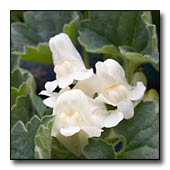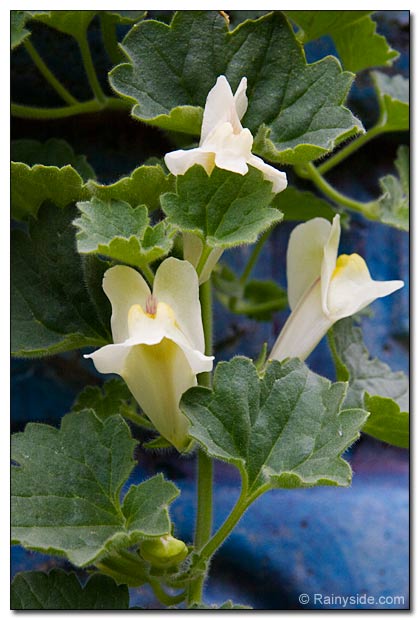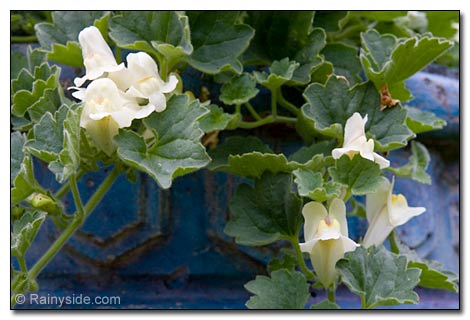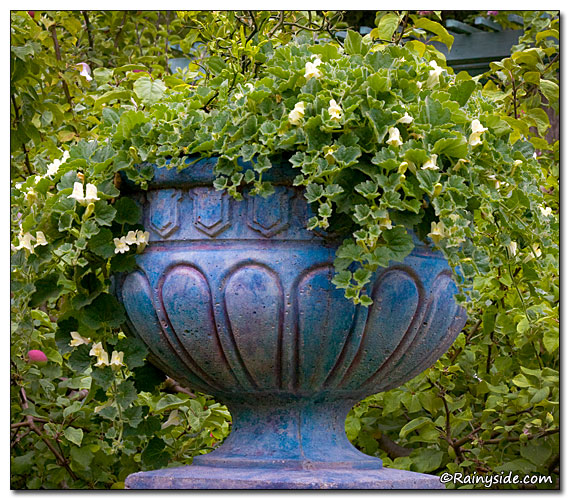Asarina procumbens
TRAILING SNAPDRAGON
syn. Antirrhinum asarina
Family: Scrophulariaceae
Pronounced: a-sah-ree-na

Quick Jumps
Growing Guide
Rainy Side Notes
GROWING GUIDE

Origin:
Pyrenees.
Plant group:
Perennials.
Hardiness:
Sunset zones: Not listed.
USDA zones: 6-9 (some sources say 7-10, 6 with protection).
Heat zones: 9-6.
Mature size:
Height: 2 inches (5 cm).
Width: 24 inches (60 cm).
Flowering period:
Summer.
Flowering attributes:
Snapdragon-like, creamy-white flowers with yellow around the opening of the throat and a spot of purple.
Leaf attributes:
Hairy, green, kidney-shaped leaves with shallow lobes.
Growth habit:
Trailing.
Light:
Bright shade, partial shade, or full sun.
Soil:
Fertile, well-drained soil.
Feeding:
In spring, side dress with a complete organic fertilizer.
Propagation methods:
In spring sow seed and keep at 61° F (16° C).
Root cuttings in summer.
Pruning methods:
N/A
Pests and Diseases:
None worth mentioning.
Rainy Side Notes

It took me a few years to understand the best garden placement for this perennial. This trailing snapdragon grows with exuberance in a container and will happily fill a pot to overflowing in short time. Growing it in the ground proved a little trickier, but I finally found its comfort zone. After finding where it wanted to live, the trailing perennial settled in and became an easy care, ground-covering perennial. Don't be alarmed! It is not a thug, at least not in my PNW garden. Even though it will colonize an area it likes, it does so politely and is easily brought back into any boundaries you set. Allan M. Armitage says it spreads aggressively, but his experience comes from the southeast part of the U.S.
The first time I saw this plant, it was growing in gravel under a carport covered with translucent PVC, and up against the north side of a building. It was never watered and yet looked surprisingly happy to grow and colonize along the building that provided bright shade. The plant trailed out from the shade, but grew sparser the further out from the shade it wandered.
In my trials, I've grown it in full shade, half shade, bright shade, and containers. Full shade was not to its liking and it petered out after one year. Partial shade took a few years, but then it began to flourish and is now filling in an area, albeit slower than I like. It is creeping through a fence to the west side, so I am watching to see where it goes for maximum growth. The soil is rich in this area, but over an old gravelly driveway.
The plant has sowed itself into some neglected containers that are never watered. It lives, but doesn't flower much. One of my containers where I planted four plants, regularly watered, and fertilized, the perennial grew and filled in the large container. In 2013, it seeded into the gravel at the base of a step under my front porch cover. As long as the plant doesn't create a safety issue, I am leaving it there and watching how it does over the next few years.
The moral of this story is Asarina procumbens prefers dry, gravelly soil in partial shade.

Debbie Teashon
Photographed in author's garden.

Gardening for the Homebrewer: Grow and Process Plants for Making Beer, Wine, Gruit, Cider, Perry, and More
By co-authors Debbie Teashon (Rainy Side Gardeners) and Wendy Tweton
Copyright Notice | Home | Search | Perennials

